Quitman was officially recognized by the Mississippi Legislature on February 13, 1839, and was named for the second Chancellor of the State, Gen. John A. Quitman. From “the ashes of destruction” in the latter stages of the Civil War, to the present day seat of county government, Quitman offers small town charm and easygoing pace of life along with a full range of modern conveniences and services. Quitman is the hometown of author Wyatt Cooper and National Basketball Association superstar Antonio McDyess. Archusa Creek Water Park is located within the City of Quitman, whose 2,000 census figures are 2,463.
Archusa Water Park
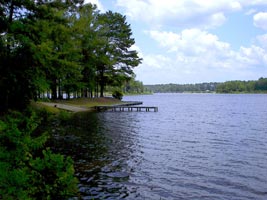
Quitman, MS.
(601) 776-6959
One thousand acres of rustic beauty located in Quitman. Cabins, camping, watersports, beaches, and winding scenic drives. Open 8 a.m to 5 p.m. Admission $1.00 per person.
Chamber of Commerce
100 South Railroad Avenue.
Serves as the welcome and information center for Clarke County. Established in 1950 with present office opened in 1987. (601) 776-5701
Clarke County Courthouse and Confederate Monument
 1912-1913 • Neo-classical Revival.
1912-1913 • Neo-classical Revival.
Principle architectural landmark of the county seat of Clarke County. The Confederate Monument, located on the lawn in front of the courthouse, has been a prominent part of the civic landscape associated with the courthouse since the monument was erected in 1911, shortly before the present courthouse was constructed. The monument is locally significant for its association with the Confederate Memorial movement, which was an important social movement throughout the South from the 1870’s until WWI. The movement was a major factor in the development of the sense of regional identity in the South during that period.
J.K. Kirkland Mercantile Store
Circa 1905 • 124 Main Street.
Kirkland building has a high degree of architectural integrity. It is a significant example of the two-story, brick commercial buildings that were characteristic of small commercial architecture during the prosperous years of the early twentieth century.
Quitman Depot
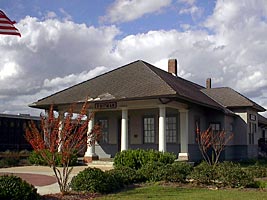 Circa 1910 • East of the railroad tracks near the junction of Main Street and Railroad Avenue.
Circa 1910 • East of the railroad tracks near the junction of Main Street and Railroad Avenue.
The Quitman depot symbolizes the importance of transportation facilities to industrial growth in Clarke County. The depot is an archetype of the station that was built in small towns all across the United States from the late 1830’s to 1930’s. It is the only existing example of a combination passenger/freight depot in Clarke County and retains a high degree of architectural integrity.
Benjamin Carter House
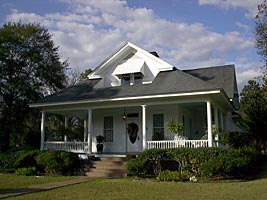
1911-1912 • Colonial Revival • 210 Ferrill Street.
The county’s best articulation of Colonial Revival style discovered to date. Significant example of how environment and culture can have an effect on a national architectural style.
Captain C.C. Ferrill House
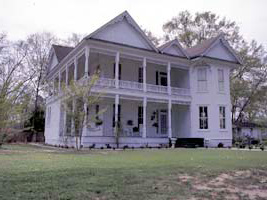 Circa 1900 • Spindlework Mode • Queen Anne • 118 East Franklin Street.
Circa 1900 • Spindlework Mode • Queen Anne • 118 East Franklin Street.
The house was originally constructed for Captain C.C. Ferrill but was purchased by the Kirkland family by 1910. The Kirkland’s were prominent business people in Quitman. The family resided here until the 1950’s. The house illustrates how the social and economic changes sweeping Clarke County at the turn of the century affected the community of Quitman.
House at 200 E. Franklin Street
Circa 1905 • Free Classical Mode of Queen Anne Style.
The house is representative of the type of housing being constructed in Quitman at the turn of the century and symbolizes the prosperity and progress that came to the community because of the Mississippi Lumber Company’s mill established here in 1900.
Donald House
Circa 1890 • 201 South Jackson.
Built in the 1890’s by George L. Donald, Sr., a major in the Confederate Army.
Trotter-Byrd House
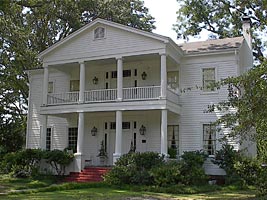 Circa 1852 • Greek Revival • 419 East Franklin Street.
Circa 1852 • Greek Revival • 419 East Franklin Street.
The Trotter-Byrd House was built by William B. Trotter, originally of Tennessee, who was an attorney in Quitman. In 1845, Trotter was a candidate for Fourth District Attorney and colonel of the 31st Regiment of the Mississippi Militia. He was elected Brigadier General in 1847. Trotter married Elizabeth Lee Terrell of Virginia in 1846. Her mother, Frances Lewis Terrell, was the granddaughter of Fielding Lewis and Catherine Washington, first cousin of George Washington. The historical significance of the Trotter-Byrd house lies in its association with Trotter, one of the country’s most important residents, and his wife, a descendant of George Washington. It is architecturally significant as one of three, two-story Greek Revival houses in Clarke County and is the only one of this group that did not function as a plantation house.
